#(that would be Untitled: Portrait of Ross in L.A.!)
Explore tagged Tumblr posts
Text
yeah, i would say "i value the end piece or the process of getting a tool to do what i want as easily as possible" describes my mindset and that of various programmers! i can't claim to speak for all but i think this is a significant part of programmer culture.
OP was fairly vague so i can't assume what kind of AI use they were talking about. but to me, the distinction is largely meaningless. i find "prompting an AI to write an entire fanfic according to your ideas" to be no different than collaging pictures together, gluing trash to a canvas, casually taking pictures with your phone, throwing pre-made game assets together, placing a urinal on a pedestal, calling a pile of store-bought candy a metaphor for your lover's death, and so on.
to me ideas like laziness and effort don't factor in (i think effort is cool but laziness is delightful too) and not even 'having the original idea' either. i do believe that if someone "picks up anything puts their name on it and proclaims it as art" then it's art, yeah! i'm a big duchampist in the sense that i think "the artist's act of choice is what elevates an ordinary object to the status of art" (to paraphrase what he said).
which is to say, i see art as a an act of curation ("i chose this object specifically", whether you made it or not), presentation ("...and you should look at it and engage with it") and self-expression ("...because i am saying something here"). as a counter-example, if someone makes ads or stock images for companies (or designs/produces urinals!), i'd call it "their creations" or "their body of work", but not necessarily "their art" or "their oeuvre", even though it involves effort, emotion, creative decisions, original ideas, and so on. unless they choose to call it art (explicitly or implicitly).
obviously this duchampist view of art is pretty extreme, but i think that by reducing the necessary criteria for "art" to the minimum, we open ourselves to new dialogues with new forms of expression, instead of doing the "but how can you call it art?" song and dance every time a new medium/tool pops up (video games, AI, the Brain Thoughts Visualizotron from the year 2125, and so on).
hopefully that makes sense!
As gen-AI becomes more normalized (Chappell Roan encouraging it, grifters on the rise, young artists using it), I wanna express how I will never turn to it because it fundamentally bores me to my core. There is no reason for me to want to use gen-AI because I will never want to give up my autonomy in creating art. I never want to become reliant on an inhuman object for expression, least of all if that object is created and controlled by tech companies. I draw not because I want a drawing but because I love the process of drawing. So even in a future where everyone’s accepted it, I’m never gonna sway on this.
#long post#again#but i like to be thorough for extra clarity! sorry lol#also you may be aware that the pile of candy example above is a real (and i'd say exceptionally important) art piece :P#(that would be Untitled: Portrait of Ross in L.A.!)#art#ai#tech#philosophy
48K notes
·
View notes
Text
SET SIX - ROUND ONE - MATCH THREE

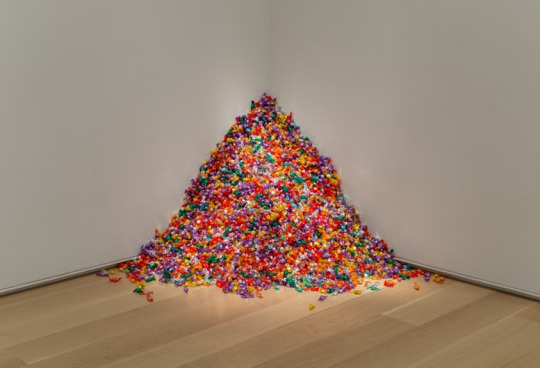
"Electric Fan (Feel it Motherfuckers): Only Unclaimed Item from the Stephen Earabino Estate" (1997 - John Boskovich) / "Untitled" (Portrait of Ross in L.A.)" (1991 - Félix González-Torres)
ELECTRIC FAN (FEEL IT MOTHERFUCKERS): it makes me literally insane that’s all that’s left of him and he made sure it would stay remembered, something something the last trace of a breath immortalized the only way it could be. Feel it, motherfuckers. (courfeyracs-swordcane) (also submitted by callixton and weeweewhirlwind)
UNTITLED (PORTRAIT OF ROSS IN L.A.): It fucks me up SO MUCH. The artist's partner was named Ross, and died of AIDS in the same year this was created. The ideal weight is roughly the average of an adult man. The allegory there... people taking the candy, decreasing the weight, the same way people took away from Ross and every other victim of the AIDS crisis by refusing to help, to do anything at all. Except this has an "endless supply" of candy. People can take and take and it keeps coming back. They can't get rid of us forever. We will prevail and we will rebuild and I WILL be fucked up about this forever (ceaseless-rambler)
("Electric Fan (Feel It Motherfuckers): Only Unclaimed Item from the Stephen Earabino Estate" is an electric fan encased in plexiglass with vinyl faux etching and a plexiglass base with casters by gay American artist John Boskovich--Stephen Earanbino's partner. It was the last item left in Stephen Earabino's estate after his death by AIDS and measures 56 7/8 x 22 3/4 x 12 1/2 in. (144.5 x 57.8 x 31.8 cm). It is held by The Museum of Contemporary Art in Los Angeles.
"Untitled (Portrait of Ross in LA)" is a modern art installation consisting of wrapped candies (constantly removed and replaced) by gay Cuban-American artist Félix González-Torres after the death of his partner, Ross, by AIDS. The weight is equivalent to a healthy human male - approximately 175 lbs (79kg). It is located at the Art Institute of Chicago, Chicago.)
#art that fucks you up tournament#polls#atfyu polls#id in alt text#did you know wikipedia has an entire page on Art of the AIDS Crisis#i am SO sorry about this matchup. like genuinely. i am torn.#GOD i cannot express how these two make me feel#feel it motherfuckers. feel his breaths. take the candy and know that we are always coming back. that is him and he is here.#idk how to insert this information but john boskovich was not left anything by his lover's family. the refusal of his love by others...#he only got the fan because no one else wanted it. more in the rbs under my main though.#ross in LA has a lot more propaganda but we're going to cycle it. if it doesn't make it past this round we'll post it all.
612 notes
·
View notes
Text
Finished 29 January 2025 (I think? This week has been an ordeal.):

Queer Images: A History of Gay and Lesbian Film in America - Harry M. Benshoff & Sean Griffin
I got this 2006 text from the library at the same time as Monsters in the Closet, and it has been weird as all hell to just be incidentally reading a history of queer censorship from the Hays Code to the Reagan-era AIDS backlash at the same time that Felix González-Torres' "Untitled" Portrait of Ross in L.A. is being intentionally abstracted from its identity as an AIDS memorial.
My oddest moment came when I read this (published, again, 3 years before Drag Race premiered): “And for a brief moment [in the 90s], men in drag became so popular that RuPaul not only became a top-ten singer but also hosted her/his own television show (248)." I wanted to be able to go back in time and tell them that RuPual has been on TV again for 17 consecutive years, and her show is franchised around the world. But at the same time, I am right now in this moment becoming concerned that my ISP may snitch on me to my landlord and/or boss if I stream it and get me evicted or fired now that our civil rights are in question again. So...conflicted feelings!
Overall, Benshoff and Griffin's work is invaluable as a monument to 20th century queer film, and, like Monsters in the Closet, I strongly recommend it to anyone who wants to learn more about what has gone before and may come again, as well as the wins along the way.
NOW, that said, I also want to highlight a few passages that, from the vantage of 2025, illustrate exactly why 1) we CANNOT dismiss work from previous eras out of hand for using terms or outdated information that make us uncomfy, and 2) we HAVE to stop basing our acceptance of queer media on the perceived sexuality and gender identities of the people involved in the production instead of the actual content.
(Please note that there are deadnames in the following passages--these are the names that these individuals were professionally known by at the time that this book was printed, and I am reproducing them as printed because of the specific point I am making by excerpting them.)
“Yet despite the beefcake and wall-to-wall camp [in Can’t Stop the Music], Valerie Perrine and Bruce Jenner are always front and center as the film’s heterosexual love interests.” (178)
The queerness of the dingdang Village People movie is qualified here because the sapphic transwoman star was still presenting as a cishet man when her character was romantically paired with another woman. I am not taking issue with the idea that it is heterosexist to deliberately include a cishet couple in an effort to tone down the gayness of a movie intended for wide release--that's obviously heterosexist. And I'm certainly not granting Caitlyn Jenner of all frickin people any kind of queer revolutionary points, because the lady ain't really a friend to the community. But gender fuckery involving crossdressing sapphics undermining hetero marriage is half the reason we consider Shakespeare a queer icon, for goodness sake, so this is a bonkers thing to read post-2015. I haven't seen this film, but it sounds to me like Jenner's character might as well be Viola to Perrine's Olivia.
But WAIT, something even more jaw-dropping happened in the chapter on 1990s films:
“Hollywood also exploited the era’s ‘lesbian chic’ via the film noir thriller Bound (1996). Released widely by Gramercy Pictures, Bound was written and directed by the Wachowski Brothers, two writer-directors who would later create The Matrix film franchise. [...] A stylish and sexy thriller, Bound allows its queer couple to have an onscreen love affair and a happy ending, a fact that pleased many lesbians in the audience. The Wachowski Brothers' stated aim was to embrace and expand film noir, to make ‘something that could push the boundaries of a genre film and still remain entertaining. . . . We tried to play with people’s expectations, their assumptions, and the clichés of a genre, including the sexual dynamics implied by these clichés.’ They even hired queer sex guru Susie Bright to be the film’s ‘technical advisor.’ However, it is also easy to see the film as yet another Hollywood made-by-and-for-men ‘lesbian’ film (such as Showgirls [1995]), one that does little to challenge usual male fantasies about female sexuality.” (258, bold mine)
Again, I am NOT arguing against the accusations that the Hollywood machine was being exploitative with this film...but the Hollywood machine is inherently exploitative, both from a capitalist financial point of view and because it is one of the primary cultural arms of US hegemony. But that "They did everything right and were intentional about upending cishet conventions, just, y'know, they're dudes, so..." take is particularly disappointing considering this footnote to a sentence earlier in the text than the above excerpt:
“The Wachowski Brothers are notoriously shy of publicity and do not give many interviews. Current gossip suggests that one of them is transgendered and in the process of transitioning to a woman. If that gossip proves to be true, public response to their popular films may shift a great deal.” (265)
Which...1) Why are we gossiping about this?? (I was an entire adult in 2006, so I KNOW why we were gossiping about this, just...gosh it's not a good look for an academic Queer Theory text, huh?) and 2)

My points here are that even people who were on the whole radically trans-positive compared to the rest of society in 2006 read as clueless at best (and honestly gross, in the case of that footnote) in 2025, and these otherwise reasonably good film analyses were still informed by the critics' understanding of the identities of individuals that would be proven incorrect in time.
Just one more argument against requiring artists to tell us their alphabet before we will interact with their work in good faith...
#no one asked you ms p#ms p reads 2025#this one got long sorry#think how far along in my paper I could be by now if I had spent my night writing it instead of this blither blather#I am fond of benshoff#I appreciate that he tempers the queer-as-monster outsider power fantasy angle of Monster Theory#with a very healthy dose of 'queer-as-monster' historically being...not great for the health and safety of actual humans#but gosh aren't cis people terrible at talking about trans issues
0 notes
Text
I CANT SLEEP SO ACTUALLY I DO HAVE TIME TO TALK ABOUT STATUES
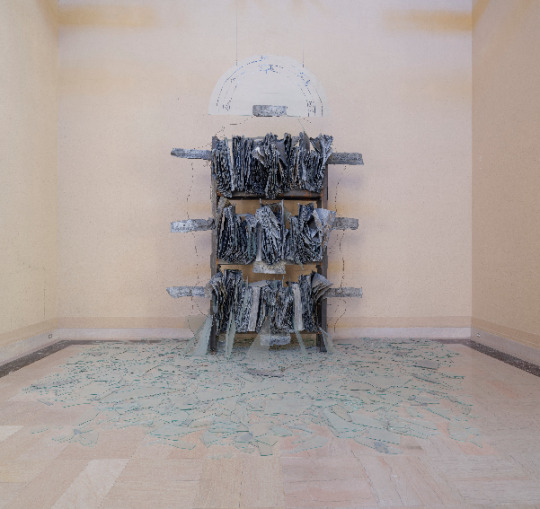
Any discussion of statues I love HAS TO START WITH Breaking of the Vessels by Anselm Kiefer. The image links to the collection page on SLAM's website, but my history and obsession with this piece extends far before I understood it in context. I was probably around 8 the first time I saw it in person, and I stood by the metal wire that keeps dumbass kids from walking into the display and looked at a sea of broken glass and metal sheeting what felt like skyscraper tall and I just felt A Lot. Like, when you're a kid, emotions are harder to name but I felt a lot of whatever it was.
Sure, you can make the argument that this piece means so much to me because as I grew up with it, so too did my understanding, but I think it's more than just its historical context. (Although divorcing it from said context does the piece a complete disservice. It's a seven ton statue that makes the plight of the jewish people a central theme without ever FEATURING A person and I think that's a miraculous feat.)

The next one is also at SLAM. Sue me, it was my local art museum growing up. Cell (Three White Marble Speres) is one of those pieces that I feel like people might point to to say "modern art doesn't mean anything" because they aren't willing to put even an ounce of work into viewing art. As a kid, it meant a lot about the way family can have a constricting nature. Now, I see it as more of a commentary on the nuclear family and the surveillance state, given the inclusion of the mirror, but in my child brain that was just so we could see the back, maybe as a reference to the past? Idk I was young, I wasn't expecting world breaking art critique from myself.
I do wish it was still on display, but I also wish I had a bajillion dollars so I could buy it and set it up in my living room. maybe i'll build myself a little copy for my desk? 10/10 great fucking statue with lots of interesting interpretations.
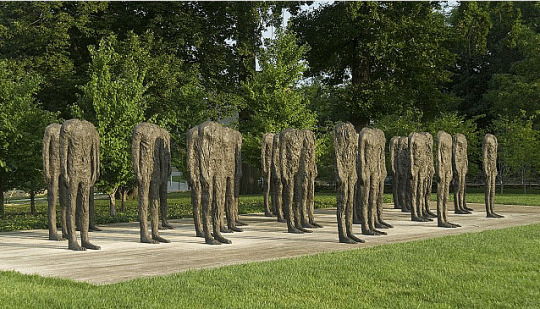
For our next one we jump over to the other half of missouri, where the Nelson-Atkins has a statue that haunts my dreams. Standing Figures (Thirty Figures) by Megdalena Abakanowicz is unsettling in the best of ways. Photos don't do it justice to stand in front of these headless figures and picture yourself among them. There's ruminations on loss of identity, but I feel like that's even a base interpretation. I want to study this piece I want to write thesis statements about it I want to meet the artist but she's dead I just
I wish part of this piece was the ability to stand among the figures because FOR ME that would be the full effect. Maybe you can, and I was just too chicken shit to do it, but I just- God I love this piece I think about it all the time.
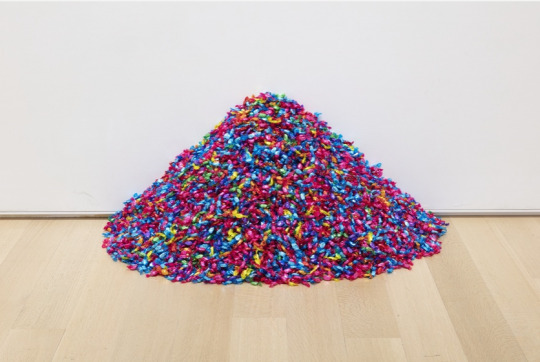
listen. I know Untitled (Portrait of Ross in L.A.) by Felix Gonzalez-Torres is a fucking gimme. I know that most of us know the story behind why a pile of candy makes me cry, by now. but I'd be lying to myself about how much I love it, if I didn't put it on the fuckin list, because I did love it and it makes me want to cry stILL
anyway my wrist still hurts but thats four statues that FUCK and also make me feel negative emotions, my favorite emotions to feel from statues
1 note
·
View note
Text
While the description change is alarming, the piece itself changing in material and display format is part of its nature intended by the artist. From Wikipedia:
"Untitled" (Portrait of Ross in L.A.) is a work of art by Félix González-Torres (or Felix Gonzalez-Torres), currently in the collection of the Art Institute of Chicago in Chicago, United States. The work is one of the twenty "candy works" in Gonzalez-Torres's oeuvre. The candy works are manifestable; the artworks are not physically permanent, they can exist in more than one place at a time and can vary from one installation to the next in response to the decisions made by the exhibitor, the interactions of audiences, and changing circumstances. This candy work has an ideal weight of 175 pounds (79 kg), representing González-Torrés' partner Ross Laycock.
A manifestation of "Untitled" (Portrait of Ross in L.A.) consists of a pile of candies individually wrapped in variously colored wrappers. Viewers are permitted to choose to take a piece of candy from the work and the caption states that there is an “endless supply” of candies.
The specific type of candy used to manifest the work, the initial choice of configuration and overall size and shape of a particular manifestation of the work are decided by the exhibitor. The candy works have been exhibited as rectangular carpets of candies, heaped in the corners of exhibition spaces, spread across the floor in organic arrangements and shaped into mounds on the ground, etc.
While the ideal weight of the work is a constant, the actual weight of the candies used to manifest the work is always in flux. The amount of candy changes as exhibitors make decisions about the weight that is initially installed, viewers choose to take candies from the work, and whether the candy is allowed to diminish and/or is replenished over the course of an exhibition. In one specific installation, art handlers at the Art Institute of Chicago recalled that the decisions for maintaining candies varied depending on visitors "During very busy periods, [we] may replenish the pile twice weekly, with approximately 45 pounds (20 kg) being added to the sculpture. On average, we add 15 or 20 pounds (6.8 or 9.1 kg) weekly." Sometimes the handlers would add candies to rebalance the piece's color.
Felix Gonzalez-Torres came up with specific and open-ended parameters for each artwork and the artist's foundation gathered information on the structure and nature of the artist's work via 'Core Tenets' for each body of work.
The Core Tenets for the body of candy works apply to “Untitled” (Portrait of Ross in L.A.)." While each body of work follows its own set of rules, Gonzalez-Torres’s practice includes purposeful variations, within a body of work and between bodies of work, in order to foster engagement and questioning.
the david zwirner gallery and the felix gonzalez torres foundation in the smithsonian removed the descriptive plaque for portrait of ross in la by felix gonzalez-torres. the old plaque explained portrait for ross' origins as the artist's partner's aids related death, and replaced it with a plaque with absolutely no information about the piece itself, who ross was, or who gonzalez-torres was either. portrait of ross was also reeranged to lay on the floor long ways instead of in a pile as it typically is situated, and the plaque outside the exhibition FOR GONZALEZ-TORRES omits his sexuality, as well as his aids related death. i'm in utter disbelief


69K notes
·
View notes
Text

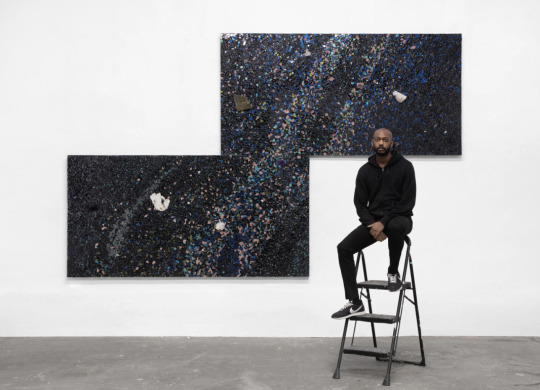


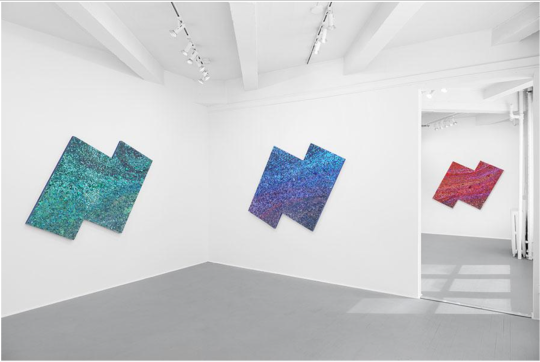
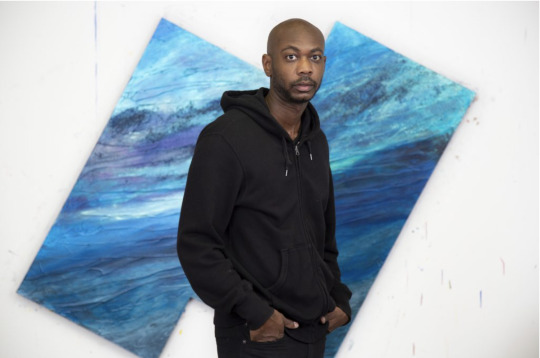
FA222 ,principles of graphic design:
Instructor: mr.munwar mukhtar
@uob-funoon @mnwrzmn
Project 1 : interviews
Alteronce Gumby on His Cosmic Abstractions
The artist talks about his practice of using glass and gemstones in his work, his inspiration behind his colours, and the cosmic and spiritual presence embedded in his paintings
BY ALTERONCE GUMBY AND TERENCE TROUILLOT IN INTERVIEWS | 23 APR 21
Terence Trouillot: Last time we spoke at Charles Moffett, you were telling me how you imagine the colour spectrum would be different on other planets. I wonder if you could say a little more about that and, more generally, how you approach colour in your work.
Alteronce Gumby: Considering that there are literally 100 billion of stars in the galaxy, and each one has its own spaectrum, we can theorize that, if I were to stand on another planet and hold up a prism to the light, I would see a completely different colour spectrum. Everything would change – from the vegetation, animals, minerals and soil to the ways that we have identified colour within society and radicalized it in terms of its relationship to identity. If I were to stand on that other planet, would I still be seen as a Black man? Would they even know what the colour black was if I were to identify myself as such? Imagining this allows me to think about the ways humans define colour and use its language to codify race and identity.
TT: This puts me in mind of Afrofuturism, which considers Blackness a form of technology for survival. Do you see your work as being inspired by Afrofuturism?
AG: In a way, Afrofuturism – including Sun Ra’s idea that Black people are from another planet – is about escape. Sun Ra is a huge inspiration for me. I really do look at my paintings as spaceships, as these vessels that can allow my consciousness and imagination to go to distant planets. I think about the images that I make as cosmic landscapes. I’m trying to imagine what it would be like to stand on another planet and to see colours not as fixed but as something that can shift.
I’m also looking more at astrophysics and thinking about the gemstones that are in each painting as actual fragments of materials forged from stars. They have this history of colour, energy and light that’s infused within their raw material, their raw colour. In a way, I see these gemstones in my paintings as carrying within them the energy of the universe. Quartz crystals give off a very strong frequency.
The world wouldn’t be what it is without these minerals embedded in the earth, nourishing the plants and animals that, in turn, nourish us. When thinking about colour, light and minerals, it’s important to remember that we’re all connected, from the micro to the macro.
TT: That’s a good segue into talking about your use of materials as a painter, working with glass in particular, but also these gemstones and activating them as part of your process. How did that all come about?
AG: I’m very conscious of the intentions I set within my work and the things I’m asking them. My sense of spiritualty comes from my upbringing. My mother was a minister and I grew up attending church in Harrisburg, Pennsylvania. I was always made aware of this being or energy in the world that was felt but not seen. I kept nourishing that, especially in my teenage years when I stopped going to church.
Thinking about the use of gemstones within holistic practices really interested me, especially in their relationship to colour. I activated them using moonlight to enable this strong energetic presence within my paintings. I wanted my paintings to feel alive. That was where I started.
The idea of using glass came to me one day when I went to the bodega near my studio to get a sandwich. I noticed that there was a pile of broken glass at a bus stop: it was glistening in the sunlight, rainbows flickering off it. I was like: that’s the most beautiful thing I’ve ever seen! It reminded me of Félix González-Torres’s Untitled (Portrait of Ross in L.A.) (1991). I took the glass back to my studio and sat with it. I didn’t really know what to do with it, but I started playing around with it, treating it like it was acrylic.
TT: In your latest work, currently on show at Charles Moffett in Tribeca and at False Flag in Queens, you’re embedding these gemstones within the substrate of the work, positioning them in your own zodiac constellations. Can you talk a little bit about how you see these abstractions as self-portraits?
AG: For me, putting these pieces of glass together was also a metaphor for putting myself together, especially in terms of my relationship to the cosmos and astrology. But then I’m also trying to redefine myself through colour, through abstraction, though the process of painting. Each piece of glass that I place symbolizes a moment of my life that has accumulated to form who I am as an individual sitting in front of you today.
TT: Your work is also about creating a shared experience for the viewer, to participate in this energy that your paintings give off. Are you at all concerned about who is actually experiencing the work or whether they will understand the holistic element?
AG: Sometimes, yes. I’d like to know everyone who acquires the work but, at times, it’s out of my control. Once these pieces leave the gallery or my studio, I can only guide the viewers mind’s eye to a certain perspective. I do my best to lay the path out for them. I put as much attention into the construction and conjuring of the painting I as possibly can, so that, when it leaves me, the intention and energy is still there, still set. I’m bringing these materials together, placing them in a certain way, making sure the alignment is right within them and that the palette they’re working with is also amplifying the colours these gemstones are presenting. But, in the end, I feel like there’s only so much I can do. I can only play the song: I can’t make you dance to it.
Alteronce Gumby's 'Somewhere Under the Rainbow / The Sky is Blue and What am I' is a dual-site exhibition on view at Charles Moffett, New York and False Flag, New York, through 25 April 2021.
5 notes
·
View notes
Text
An Introduction to Contemporary Art
This blog is dedicated to my experience surrounding Contemporary Art as a first year undergraduate student at Liverpool John Moores University. Throughout this assignment I will use this blog as a platform to record my expanding knowledge of Contemporary Art through the module lectures, in conjunction with my own experiences and research.
My name is Eve, my pronouns are she/her. I am nineteen years old, living in Liverpool.
What does Contemporary Art mean to me?
When first considering what does Contemporary Art mean to me, I found no singular answer. To put a definitive label on Contemporary Art would contradict the nature of it, as it does not fit into any particular artistic category - there is no conformity to concept, the materials it uses or the way in which it is displayed. It seems to me that it is a shape shifting term.
However, there does seem to be one link that runs throughout all Contemporary art and artists. What seems to be persistent is the focus on the ‘concept’ relating to the time in which it was made - the relevance and the idea of a piece often being paramount to the aesthetic.
My Experience with Contemporary Art
My first glimpse into the Contemporary Art world was not a positive experience. Like a large group of the general public, I did not always have interest or perhaps the respect that I do now for the seemingly elite group of art, artists and galleries that are branded as ‘Contemporary’. Growing up in a non-artistic, non-academic background, there was a general consensus that there was ‘good’ and ‘bad’ art. The ‘good’ art was that which showed great technical skill and ability, something that only those most gifted could produce; the ‘bad’ was ugly, hard to understand and pretentious with no rationale for being so -Contemporary. When I initially became interested in art, I began to visit Contemporary ‘white cube’ galleries and I felt fraudulent standing there, silent, contemplating a work, which truthfully, I could not cultivate a deep or meaningful relationship with. Contemporary artwork felt very inaccessible to me, I felt left out of the secret, as much as I wished to be initiated in the club.
However, over time I broadened my horizons. I was struck so forcefully by my discovery of leading Contemporary artist of the 20th Century- Jean Michelle Basquiat. For me, this was the beginning of my own exploration of the Contemporary Art world. Basqiuat’s raw and intense excitement shown in his paintings, drawing and graffiti spoke so clearly of the social injustice he experienced. The narrative of those marginalised shown within each scribble, clashing colour and line, attacking the structures of power and and speaking of his experiences within the black community in New York in the 1980’s. The relevancy is still felt so much today, transcending the time in which it was made.


Bird on the Money (1981) Jean-Michel Basquiat

Acidquiat (1980) Jean-Michel Basquiat While Basquiat was the first Contemporary artist that sparked my interest, my most recent curiosity is with Felix Gonzalez-Torres. More specifically, the work Untitled (Perfect Lovers) which consists of two battery operated clocks, set at the same time and are placed touching on the wall. At the time of conception of the piece, both Gonzalez and his boyfriend Ross Laylock were dying of AIDS. Gonzalez said that creating the work terrified him, he used it as a way to face up to the fleeting time he had left both with his love, Ross, and of his own life. The idea being that the clocks would eventually go out of sync (as lovers do) and eventually one would stop completely. This work, without any painting or particular skill exists only as a concept, still so poignantly expresses the meaning which all humans can relate their lives to - a great reflection of the transience of life. Another work that fascinates me by Gonzalez is (Untitled) Portrait of Ross in L.A. which was recreated a series of times. This installation is a pile of colourful wrapped sweets, which the public are encouraged to take away with them. Dimensions vary with installation however it ideally weighs 175lb, which was Ross Laylocks weight when healthy. The concept being the depiction the effect AIDS had, causing the decline of Ross’ health over time, reflected in the diminishing sweets - it is as if the viewers are taking a piece of Ross Laylock away with them.

(Untitled) Perfect Lovers (1991) Felix Gonzalez-Torres

(Untitled) A Portrait of Ross In L.A. (1991) Felix Gonzalez-Torres


A love letter from Felix Gonzalex-Torres to Ross Laylock (1988)
3 notes
·
View notes
Text
I've quite enjoyed this little series, so now that it seems to be wrapping up, it seems like a good time for a little retrospective.
DJing
It's performance art, unless literally all you're doing is letting the songs play in the order you selected. But even then, you probably curated the playlist, which is a kind of art in its own.
AMVs
This is art at least to the same extent as any other kind of video editing, and I would argue more so in some ways.
Meme Edits
Taking something and putting it in a different context (which is what this amounts to) is pretty much always art.
Vocaloid Songs
Whatever else you are or aren't doing here, you're writing and/or arranging a song, which is pretty indisputably art.
Picrew, Mario Maker, & Miis
Grouping these together because they're all in kind of the same category, which they share with things like Lego sculptures and interior design. "Here's a bunch of stuff, put it together how you like." How could that not be art?
Blackout Poetry
This is in some ways the opposite of meme edits, where instead of taking something and putting it in a different context, you change something within its context to make something new.

Duchamp's Fountain
This in some ways reminds of of Diogenes going "Behold, a man!", but in other ways it's kind of the opposite. When Duchamp goes "Behold, art!" with this, it's partially satire, yes, but also partially genuine and partially a challenge. Who are you to say it isn't art?
"Untitled" (Portrait of Ross in L.A.)
I had to look this one up, but, uh... yeah. Art. 's weird.
407 notes
·
View notes
Photo



Physical Representation of Loss - Felix Gonzales Torres
González-Torres's openly gay sexual orientation is often seen as influential in his work as an artist. González-Torres was known for his minimal installations and sculptures in which he used materials such as strings of lightbulbs, clocks, stacks of paper, or packaged hard candies. In 1987, he joined Group Material, a New York-based group of artists whose intention was to work collaboratively, adhering to principles of cultural activism and community education.
“Untitled” (Portrait of Ross in L.A.) consists of commercially available, shiny wrapped confections. The physical form of the work changes depending on the way it is installed. The ideal weight of the work, 175 pounds, corresponds to the average body weight of an adult male. As visitors choose to take candy from the work, the volume and weight of the work decrease. In early showings he prohibited the photographing of his work in the gallery, instead insisting the audience simply just experience the piece. Could this piece be defined as non-commodifiable if there is eventually no object left? And ideally there would be no photographic record of the peice?
One of the themes of his practise was to physically represent emotions, particularly feelings of loss and time passing. The idea of the audience physically taking from the object, depleting it until nothing exists is an interesting concept.
4 notes
·
View notes
Text
Felix Gonzalez-Torres "Untitled" (Portrait of Ross in L.A.) (1990)
Gonzalez-Torres uses commonplace objects to convey intimate expressions of loss and mourning. Among his variations on conceptualist design are the "stacks": reams of industrial paper printed with photos, texts, or abstract designs. These are arrangements of paper stacks on the floor of the museum or gallery space.

The first stacks were done as memorials, roughly the same size and shape of a tombstone. Gallery visitors are invited to take one of the sheets that composed the pile as they passed by, and this act is crucial to the meaning of the work. So even while these pieces elicit gravestone associations there is an anti-monumental quality to these moving sculptures. This work came about from the artist's desire to do a show that would totally disappear.

Gonzalez-Torres began his signature stacks and spills as he faced the imminent death of his lover stricken with AIDS. According to the artist, this use of a fluctuating form was a way of externalizing emotion, of anticipating and grieving the death of his lover.
2 notes
·
View notes
Note
I go to the Albright Knox in Buffalo pretty regularly bc it’s very close to me but my favorite experience going was when they had two Felix Gonzales-Torrez pieces on display and I didn’t know about it before hand, it was such a nice surprise. One of the pieces was the pile of candy (the title escapes me rn) and I was really moved by actually having the chance to decide to take a piece or not. I decided not to bc of what the work represents but I loved the experience.
Oh wow that would be a really intense and emotional piece to see in person. For those of you who aren’t familiar, the piece called, Untitled (Portrait of Ross in L.A.) which consists of a 175lb pile of candy. The healthy weight of the artist’s boyfriend who died in 1991 of AIDS. Viewers are encouraged to take a piece of candy (which represents love, comfort, caring for someone who is sick), as they do, the pile gets smaller, and the ‘body’ wastes away.
It shows how you can’t really do anything to help someone you love when they are very sick.
19 notes
·
View notes
Note
please read the thread OP linked on how exactly AI art models work before arguing with me.
okay. now that we’re back, i would like to walk you through a thought experiment.
is this pile of candy, called Untitled or Portrait of Ross in L.A., a work of art?

many of you know of this installation already, but for those who don’t, its creator was a queer artist named felix gonzalez-torres.
Félix González-Torres (1957-1996) started a series of works in 1990 that all consist of small, hard candies in variously coloured wrappers. They are either spread out in rectangles on floors or put into piles. Some other works in this series are called Untitled (Lover Boys) and Untitled (Welcome Back Heroes). In each instance viewers are invited to take a piece of candy—to suck on, to keep, to share. This, of course, risks the loss of the installation entirely, but the instructions are that they are to be constantly replenished with an endless supply. Untitled (Portrait of Ross in L.A) comes with instructions from the artist to keep it at an ideal weight of 175 lb.
Although it avoids literal representation, this is a work about queer desire, queer bodies, and queer history. It is named after his love and life partner, Ross Laycock, and is about his personal experience of AIDS as well as the AIDS Crisis as a whole. The ‘ideal weight of 175 lb’ is a reference to Ross’ healthy weight, which diminished because of the virus. Ross died from complications due to AIDS on January 24th, 1991, and Félix would go on to make this work later that same year. (source)
gonzales-torres did not make or wrap the candy. he did not create the installation. he does not participate in the consumption actively, although i imagine he would have if he visited a museum with the piece displayed before his passing. he does not have any control on the specific brand of candy that curators do except iirc a suggestion. by no standard did he "create" this in the sense that people who care about AI art discourse would agree on.
yet somehow, it is abundantly clear that this is a work of art that was created by gonzales-torres.
art is so much more than the mechanical process taken to render its visage. in my opinion, the most important part of art is a vision, a specific goal or experience or interaction that the medium of the art form is intended to evoke. whether that vision is mundane & simple or so unique & evocative that it brings you to tears, it’s still art.
anything can be art, even a list of instructions, so long as it has a vision or desire or expression behind it. even art created via AI generation.
a human is still inputting prompts, you know. a human is still fiddling with the what words to use to get this tool to create a particular visual message. even if message is generic slop, even if it’s ugly or strange or boring, it’s still fucking art if it has an intention behind it.
AI generators do NOT make collages (see above thread), but since people like to use it as a talking point, collages are art too! taking the exact physical words and images someone else created and arranging them into a new position according to your own design is art! using pieces that others created to build something different is the literal basis of all human creativity and ingenuity.
additionally, there is no such thing as original art. everything you have ever made was inspired or informed by thousands or millions of similar things that came before it made by other people, whether you know it or not. there is literally nothing new, only different. this is not a bad thing.
the sooner everyone can get off their high horse about the sanctity of art and what’s “real”, the better off we’ll be. the fact that corporations are using AI models to exploit their employees and put people out of jobs and the potential for misinformation are the real issues here, and that has NOTHING to do with how artistically authentic or creatively original AI models can be. building strong unions and labor protections is what matters, and that is what will help creative professions the most. idk how to solve the misinformation issue honestly, but talking about any solution is better than waffling about “real” art.
i mentioned that AI art is a good tool for disabled people and someone was like "disabled people can make art without it!!! arm amputees can use prosthetics or paint with their feet, most digital art apps have stabilization for people with tremors!!" like yeah... amputations and tremors... the only 2 disabilities...
real talk I am not fucking learning to paint with my feet. why don’t you do it if it’s so easy. Fuck off (that is to say I agree with you anon)
635 notes
·
View notes
Text
I always felt like the response to "Untitled" (Portrait of Ross in L.A.) should be that the audience would be moved to bring candy to the piece and replenish it themselves but with the work now so established I feel like I wouldn't have the balls to actually do that
0 notes
Text
Discussing a discussion.
Seeing as this blog is a part of my uni degree, for my contemporary art module, I feel that I should offer a reflection on my first ever contemporary art session. Whilst not technically a “discussion session”, a very interesting conversation certainly took place.
I would in no way describe myself as someone who is familiar with a lot of contemporary art pieces, and likely for this same reason I would not say that I dislike contemporary art. I feel I do not know enough to offer an opinion of distaste which can be sufficiently backed up. Basically I think that to dislike something you should at least know why. Anyway, what I do know is that I always enjoy learning about new art, no matter when it was created.
However, during the first contemporary art session it became clear that numerous people in the group had already made up their minds. That is to say, most preferred older styles or the more stereotypically “aesthetic art” you’d likely find prints of being sold on Etsy for a ridiculous price (think Botticelli’s Primavera). Personally, I love this sort of art too but my favourite kind of art is that which has a story, a deeper meaning with something to say. Often I find that the less immediately obvious the story behind a piece is, the more I enjoy looking at said piece once I know what’s really going on. Take for example the images below of Félix Gonzáles-Torres’ piece untitled (portrait of Ross in L.A.), at first glance the installation is nothing more than a pile of sweets. However, once you learn that the piece is a representation of Torres’ lover’s decaying body, suddenly the 175lbs worth of candy weighs so much more. Thus, I have a lot of time for contemporary art and its sometimes hidden or obscure meanings.

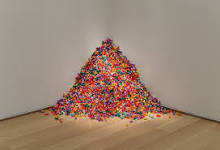
This was not the overall consensus of the group. It seemed as though the lack of a universal definition for contemporary art left people feeling unable to engage. If the audience are already approaching the work from a place of misunderstanding, how can they then be expected to connect with it? This dilemma is one which many curators will attempt to tackle whilst struggling to define the age old question: what even is contemporary art anyway?
It was striking to me that people could just push aside what they didn’t understand, and I would say that once this was brought to attention it shocked everyone else too, including those guilty of doing just that. These days it is so easy to ignore anything that doesn’t provide instant gratification. Constant media consumption has ruined our attention spans and it seems like no one has time to reflect anymore. Not unless prompted anyway. Perhaps that’s why so many claim to dislike contemporary art. Arguably, it requires more than just a brief glance at the piece, viewers are expected to see rather than just look – something which takes longer than the 15 seconds someone may take to appreciate something such as Monet’s water lilies. Not that I don't love those too!!
But therein lies the ‘problem’ with contemporary art. Its discursive nature means there is always room for dialogue between viewer and artwork, something is always up for interpretation. Effort is required to reach a satisfactory conclusion or opinion. This is where people must decide, does art always need a meaning?
As I am writing this reflection close to the end of the semester I have seen the impact of this first session in full. The questions asked certainly prompted people to engage more with contemporary art and to accept that sometimes pieces don’t have a clear interpretation right away. I have witnessed those who previously disregarded contemporary art spend time with pieces they would have deemed ‘pretentious’ at the beginning of the semester. Thus maybe the future of art is dependent on tolerance. As we move further into the digital age and embrace technology such as NFTs, VR, and AI art, viewers will need to adapt to new mediums and be willing to spend time with pieces perhaps presented in an entirely new way. If this is the case then it could be that contemporary art will never have a universal definition as such, but its ever-changing nature may come to define it. And this is just something we will all have to accept - or at least those are my thoughts anyway.

Real footage of me writing this ramble ^
1 note
·
View note
Text
Idea #1 Research:
This artist Annelies Van Overbeek, on Instagram, uses hair to create jewelry. I think there’s a remarkable relationship with time here, these are grown out pieces of people preserved and placed with chains to be worn. I chose this because it’s a wearable object made from something you would not really think of being wearable. I cannot link this image because of Instagram but the @ is @ vanoverbeekannelies. Specifically this post: https://www.instagram.com/p/CZC5sn4g6S3/?utm_medium=copy_link
Idea #2 Research:
Felix Gonzalez-Torres’ piece Untitled (Portrait of Ross in L.A.). This installation piece uses a pile of candy that the viewer is asked to take away from. This depicts the loss of weight and eventual complete disappearance of the form to represent Felix Gonzalez-Torres’ lover whom died of AIDS. I chose this work because it is a representation of an individual and mortality, which I think this idea relates to as well.

Idea #3 Research:
_To Disembark: Billie Holiday, _by Glenn Ligon, is part of a series of wood crates with audio playbacks emanating from them, these crates relate back to a story of a slave mailed in a crate to get his freedom. This work essentially creates a time portal in the room it exists in. I chose this piece because although it’s not too similar to this idea, it uses audio in a unique way.

0 notes
Text
Carousel Tutorials 5/11/21
Friday 5th November 2021
Over the last few weeks, I’ve been thinking quite in depth of my practice and where it’s leading me. I decided at the beginning of this semester that I would follow on from last semester’s theme of idol worship, however, taking a route centred on the veil of invincibility these idols wear. I had the initial idea of portraying them as God-like, mythical beings.
We’ve had a carousel of different tutors for the past three weeks and I’ve received a range of feedback on my work.
The first tutor, who I unfortunately can’t remember the name of, seemed unsure of my practice. She expressed that because my work mainly consists of portraits of famous figures, that it was infantile, lacking depth and obsessive. This frustrated me, as I’d explained that my work revolves around the relationships between people in power – or of a high status – and their loyal followers and is not simply glorified fan-art. For a long time, I’ve been interested in how these figures influence those that idolise them, despite their followers only knowing a public image rather than the real person behind it. It’s fascinating to me how close we can feel to our idols sometimes, so much so that parts of our personality and self-expression are borrowed from them, and they slowly become a part of us, just like the people we surround ourselves with every day. This discussion didn’t feel like a crit, but more like my work was being picked apart unfairly. It made me consider an alternate view: if I was male, would my work still be viewed as ‘obsessive’? Reduced to being labelled as ‘silly fan-art’, therefore having no depth? I understand that this is only one person’s perspective of my work, but it has been making me question what more I can do with my art to ensure that I’m communicating my ideas clearly to everyone who views it.
For the second week of the carousel, I had Roy, who was much more helpful in showing me different ways of expanding my practice. Roy pointed out that I seemed to already have a plan, which they said wasn’t necessarily a bad thing, but that it would be good for me to venture outside of the pathway I’d already set out for myself. I mentioned that I mostly focus on portraiture because I’m fixated on faces, but that sometimes I do find it tedious. Roy encouraged me to investigate portraiture more, by discovering how far one can push its boundaries. They explained that a portrait can take the form of readymade objects; we discussed Felix Gonzalez-Torres’ work ‘Untitled (Portrait of Ross in L.A.)’, where Ross, Gonzalez-Torres’ lover, was portrayed as a diminishing pile of sweets, symbolising his deteriorating health and weight loss after his AIDS diagnosis.

We also discussed the music video for ‘Don’t Touch My Hair’ by Solange, directed by Alan Ferguson and Solange herself.


The video contains shots mirroring artworks by artist Lynette Yiadom-Boakye, which show fictitious black figures in ordinary scenarios. The portraits are painted in a way that allows the viewer to see themselves in them, as all the situations are very mundane. Roy explained that the concept of creating a portrait of no one specific offers heavier relatability to its audience, as it requires no background context. I find this concept interesting as my portraits tend to be too specific to the subject. There’s nothing wrong with this, however, it could help my practice to be understood more if the subject was a little vaguer.
This week I spoke to my normal tutor Rick, who out of the three tutors I’ve seen has the most background knowledge of my practice and its progression. We concluded that the initial idea mentioned above of idol worship was a little too ambitious as it isn’t broad enough. I explained that despite this I’m still very interested in fairy tales and children’s stories and wanted to include them in my artwork somehow, and Rick wanted me to dig deeper and find out why this is. To discover why I feel an almost gravitational pull towards child-like themes. I’ve felt quite lost with my artwork this year as I’ve had many new ideas but struggled to communicate them properly, or even to just put them to paper at all. Getting back into creating things again has been difficult, and I think the one thing making it worse is feeling as though I must know where my practice is leading, and what each complete piece should look like. I have many concepts in mind that I want to try but trying to make sense of them and link them all together has become stressful, so I’m taking a step back to reassess it all. I came to the realisation last year that my practice always leads back to the theme of childhood one way or another, so it seems to be more natural to investigate that pathway more. I’ve learned that my artwork is an extension of myself, and so I should start with ideas that I’m most familiar with first before I venture elsewhere.
1 note
·
View note